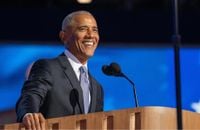As the United States barrels toward another pivotal midterm election season, the first major tests of voter sentiment are already underway in several states. On the weekend before the November 5, 2025, elections, former President Barack Obama stepped back onto the campaign trail, lending his enduring star power to Democratic gubernatorial candidates in Virginia and New Jersey. His appearances in Norfolk and Newark were not just routine rallies—they were high-stakes efforts to energize the Democratic base at a moment when the political climate feels as charged as ever.
Obama’s itinerary was carefully curated. In Virginia, he joined Abigail Spanberger, the Democratic candidate for governor, at a rally designed to rally support in a state where the outcome will make history. According to Reuters, this race will elect Virginia’s first female governor, and if Republican nominee Winsome Earle-Sears prevails, she will become the first Black woman governor in U.S. history. Later that day, Obama traveled to Newark, New Jersey, where he appeared with Mikie Sherrill, another prominent Democratic hopeful. Both events were positioned as final pushes before voters head to the polls, and as iNews reported, the stakes couldn’t be higher for national party strategy.
The context of these elections underscores their significance. As CNN highlighted, they arrive nearly a year into Donald Trump’s second presidency—a political reality that has shaped the tone and focus of campaigns in both parties. The outcomes are widely seen as bellwethers for the national mood, offering clues about the issues animating voters and the prospects for each party as the 2026 midterms loom.
Obama’s involvement has been especially noteworthy given the current landscape of Democratic surrogates. As iNews pointed out, the party has few figures with his level of popularity and ability to command attention. His presence is a reminder of the importance of maximizing turnout among the Democratic coalition, especially as Republicans look to make gains by focusing on local issues and economic anxieties.
In Virginia, the contest between Spanberger and Earle-Sears has been closely watched not only for its historic potential but also for its reflection of broader national trends. As Rolling Out reported, Obama used his rally to draw a sharp contrast between the candidates, warning voters about the dangers of what he called Trump’s “lawlessness and recklessness.” In his words: “The stakes are now clear. We don’t need to speculate about the dangers to our democracy.” He urged Virginians to “set a glorious example for the nation” by rejecting candidates aligned with Trump, whom he accused of harboring “autocratic impulses.”
Meanwhile, the Republican candidates have taken a different tack. Earle-Sears in Virginia and Jack Ciattarelli in New Jersey have both sought to localize their campaigns, focusing on state-specific concerns rather than getting bogged down in national controversies. As Rolling Out noted, Ciattarelli criticized Sherrill for her frequent references to Trump, questioning whether her background as a Navy helicopter pilot would translate to solutions for New Jersey’s pressing issues. While Trump himself did not appear in person—spending the weekend at Mar-a-Lago—he did endorse Ciattarelli and held a phone rally, keeping his influence alive among the conservative base.
Economic concerns have dominated the conversation in both states. Rising consumer costs, higher energy prices, and the impact of the ongoing federal shutdown have all become flashpoints. In New Jersey, where the incumbent Democratic Governor Phil Murphy is ending his term, both parties have made affordability a central theme. According to CNN, debates over utility rates, taxes, and clean energy policy have taken center stage, with Republicans accusing Democrats of overreaching and Democrats touting efforts to freeze rates and protect consumers. These issues have resonated deeply with voters, especially as the cost of living continues to climb.
Social issues have also played a prominent role. Spanberger and Sherrill have both been outspoken in their support for abortion rights, while Earle-Sears has targeted Spanberger’s stance on transgender rights, echoing strategies previously deployed by Trump. As Rolling Out observed, this dynamic reflects the evolving priorities of the electorate and the ways in which national debates are filtering down to state-level races.
But the electoral action isn’t limited to Virginia and New Jersey. Across the country, other contests are shaping the political landscape. In New York City, the mayoral race features Democratic nominee Zohran Mamdani, former Governor Andrew Cuomo running as an independent, and Republican Curtis Silvoy. As Bloomberg reported, Mamdani—a democratic socialist who energized young and progressive voters—won the Democratic primary, making the race a defining test for a party navigating internal divisions and seeking a path out of political isolation. National Democrats have offered varying degrees of support, with Obama calling Mamdani to praise his campaign as “impressive to watch,” though stopping short of a formal endorsement.
California, meanwhile, is grappling with a statewide referendum that could redraw its congressional map to favor Democrats, a move designed to counter Republican-led redistricting efforts in states like Texas. As Reuters and CNN both noted, this is part of a broader national battle over the rules that will shape the next Congress. In Pennsylvania, voters are deciding whether to keep three Democrats on the state Supreme Court, a decision that could have lasting implications for redistricting and the 2028 presidential campaign. Special elections in Texas, particularly in the 18th House District, are also drawing attention, with familiar faces and newcomers vying for seats in Washington.
All of this is unfolding against a backdrop of economic anxiety and political polarization. The main themes—rising prices, energy costs, and regulatory decisions—continue to shape voter sentiment and define the policy trajectory for the near future. As CNN put it, these elections are not just about who wins or loses, but about which issues will remain decisive as the country heads toward the next round of national contests.
Obama’s rallies in Virginia and New Jersey serve as a vivid reminder of what’s at stake. With both parties deploying different strategies—Democrats leaning into national concerns and the defense of democracy, Republicans focusing on local issues and economic management—the results of these races will offer an early signal of the political winds heading into 2026. Whether the Democratic Party can sustain influence in key states, or whether Republicans can capitalize on voter frustration, will become clearer in the days ahead.
For now, one thing is certain: these elections are about much more than individual candidates. They are a referendum on the direction of the country, the state of its democracy, and the priorities of its people. As the votes are counted and the dust settles, the lessons learned will shape the campaigns—and the country—for years to come.






